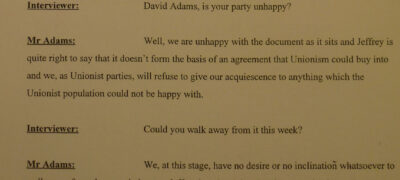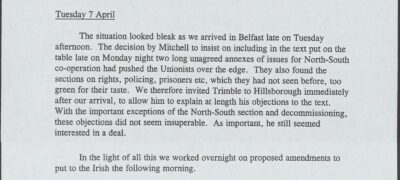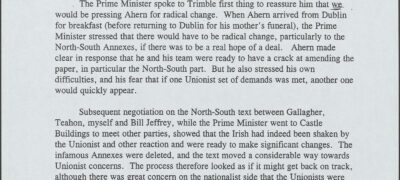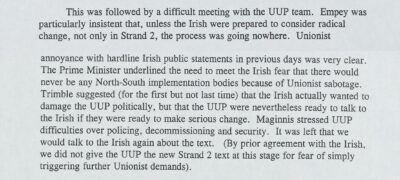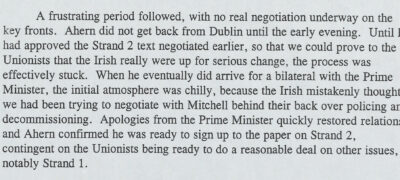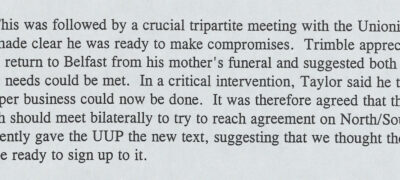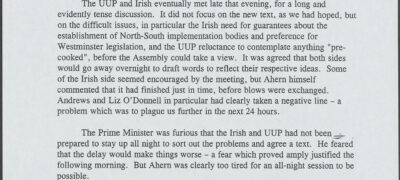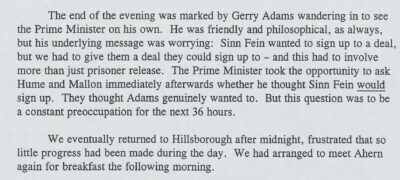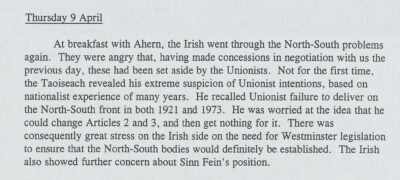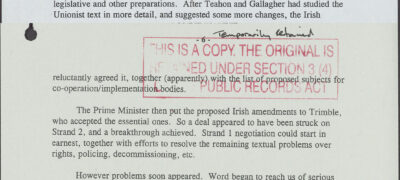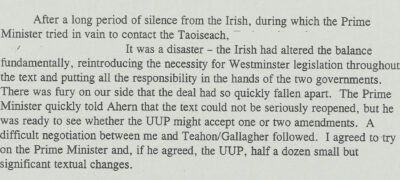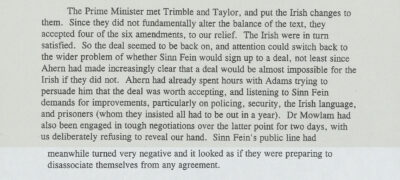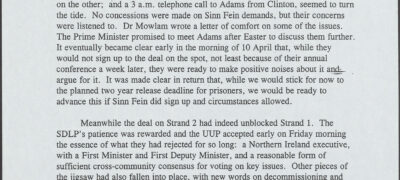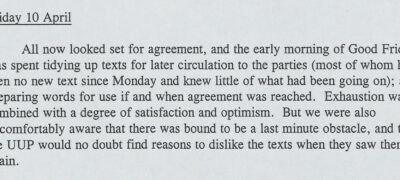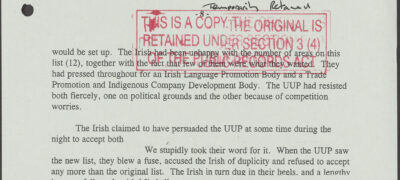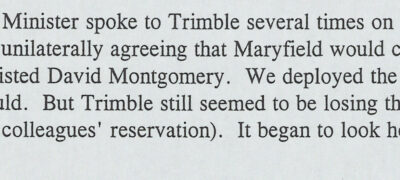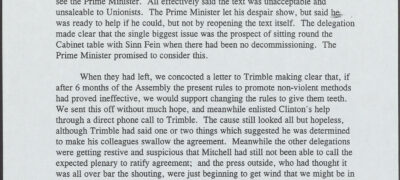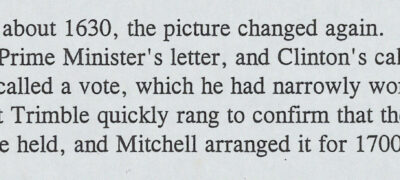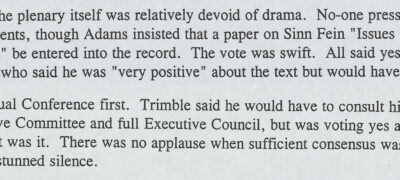
Download documents and transcripts
Teachers' notes
The two documents selected within this package (one from the National Archives of Ireland and one from the National Archives in Kew) reveal the doubts about whether a peace agreement for Northern Ireland could be reached just days before it was finally signed by all parties. The documents also cover all the twists and turns of the final 72 hours of negotiation.
It is expected that students will already have completed ‘The Road to the Belfast (Good Friday) Agreement’ lesson pack, although this is not essential. This lesson provides a contrast to that lesson: whereas the previous lesson focussed more on the barriers to peace, this centres more on how agreement was reached.
In the main activity, students are encouraged to analyse extracts from a long document, a report on the final 72 hours written by John Holmes, Principal Private Secretary (PPS) to Tony Blair. In a similar process to lessons 1- 2, they need to look for:
- any evidence that the talks are going well or that an agreement is close
- any evidence that there are still challenges or that agreement seems far away
- key turning points / actions of individuals that make breakthrough possible
They will chart the progress of the negotiations by plotting the 20 points on a graph to represent them in a visual form (teachers may wish to remove extracts in order to cut down the number students need to examine).
Learning objectives
By the end of the session, students will:
- know what barriers still stood in the way of an agreement, 7–10 April 1998
- understand how the Belfast (Good Friday) Agreement was finally achieved
- be able to use contemporary documents to deepen your understanding
Download the resource pack below:
Download the Powerpoint (3.47MB)
Lesson at a Glance
Suitable for:
KS3
Time period:
Post-war, 1945–present
Connections to the curriculum:
Challenges for Britain, Europe and the wider world, 1901 to the present day
Prior Knowledge:
It is recommended that students watch the video From Conflict to Peace available on The National Archives website https://www.nationalarchives.gov.uk/education/resources/belfast-good-friday-agreement/ and on YouTube https://www.youtube.com/watch?v=VQXBpt5RArY and undertake the discussion activity to gain an overview of The Belfast (Good Friday) Agreement and what it achieved. The discussion resources are available from https://www.nationalarchives.gov.uk/education/resources/belfast-good-friday-agreement/bgfa25-discussion-activity/
In addition students should undertake the ‘Road to the Belfast (Good Friday) Agreement’ lessons before completing this lesson.
Tasks
Starter activity: Can you guess the date of this document?
Hand out the starter document. It is important that if you give students the full version that you cover the date!
Starter document: Catalogue reference (NAI): P1140529. A transcript of an interview from a TV news programme in Northern Ireland, Live at Six
Students need to examine the document on Slide 1. This is an extract on from the transcript of an interview on 07.04.98 on UTV’s Live at Six with Jeffrey Donaldson of the Ulster Unionist Party (UUP) and David Adams of the Ulster Democratic Party (UDP) in which both, Donaldson particularly, express dissatisfaction with the proposals for an agreement, with Donaldson describing them as ‘some sort of charter for a United Ireland’. There are some questions on the slides to assist students in analysing the document (alongside a reminder of the date on which the Belfast (Good Friday) Agreement was signed):
- What do you think this document is?
- Are Jeffrey Donaldson and David Adams Nationalists or Unionists? (They are both Unionists)
- Do they seem satisfied or dissatisfied with the peace talks so far?
- From their point of view, does it seem like an agreement is near or far away?
Students need to choose the date they think the document is from:
- 7 June 1996
- 7 October 1997
- 7 February 1998
- 7 April 1998
If they have completed Lesson 1–2, and knowing the date of the actual agreement, they are likely to pick A, B or C.
Teachers should then use Slide 3 to reveal the actual date, just three days before the Agreement was signed, and invite answers to the final question on the slide, i.e. What might this suggest about the final days of negotiation leading up to the Agreement?
Teachers can then use Slides 4–8 to introduce the focus of the lesson. The timeline on Slide 8 provides some information on some of the key events which have occurred between October 1997 (where Lesson 2 ended) and the beginning of April 1998, where this lesson kicks off. Teachers should note that there are numerous terms on the timeline – people and acronyms – which will require teacher explanation. They are not on the timeline in order to keep it concise.
The following list of terms may prove helpful:
- Articles 2 and 3 of the Constitution of Ireland – stated that the whole island of Ireland was Irish national territory, thereby claiming Northern Ireland to be part of a united Ireland.
- DUP – Democratic Unionist Party – a unionist political party
- IRA – Irish Republican Army – a republican paramilitary group. Sometimes called the Provisional IRA (PIRA) or the Provisionals.
- Loyalist – militant Unionists often associated with violent paramilitary groups such as the UVF and UFF
- Maze prison – a prison in Northern Ireland used to house republican and loyalist paramilitary prisoners.
- Mo Mowlam – Secretary of State for Northern Ireland, a member of the UK government, who led the government of Northern Ireland before the Belfast (Good Friday) Agreement.
- Nationalist – supporter of Northern Ireland leaving the United Kingdom and joining a united Ireland
- Paramilitary – an armed group that used violence to try and achieve its goal. There were paramilitary groups on both sides of the conflict such as the loyalist UVF and the republican IRA.
- Republican – militant Nationalists often associated with violent paramilitary groups such as the IRA
- Senator George Mitchell – an American politician who chaired the app-party talks that led to the Belfast (Good Friday) Agreement.
- SDLP – Social Democratic and Labour Party – a nationalist political party
- Sinn Féin (SF) – a republican political party linked to the IRA
- Unionist – supporter of Northern Ireland remaining in the United Kingdom and opposing a united Ireland
- UDA – Ulster Defence Association – a loyalist paramilitary organisation
- UDP – Ulster Democratic Party – a loyalist political party linked to the UDA
- UFF – Ulster Freedom Fighters – a loyalist paramilitary organisation
- UUP – Ulster Unionist Part – a unionist political party
Main activity: How was peace achieved in the final 72 hours of negotiations?
Catalogue reference for all extracts: PREM 49/412 Extracts from a report written by John Holmes, who was Principal Private Secretary (a senior official) to the UK Prime Minister, Tony Blair.
The report, written on 13 April, lays out his account of the final days of negotiation before the Agreement was signed on 10 April.
Students should look at each extract from the document. They should be encouraged to look for:
- any evidence that the talks are going well or that an agreement is close;
- any evidence that there are still challenges or that agreement seems far away.
This should be done before plotting the document on their graph (Slide 11).
For each document, there are some brief notes, which may assist in students’ understanding and analysis (note that these are not repeated with each subsequent extract, e.g. ‘Taoiseach’ is only explained the first time the word appears). Nevertheless, there are undoubtedly technicalities to the negotiations which students will find challenging; they should be encouraged to focus on the tone and pace of the negotiations and the relationships between the key players, rather than getting too bogged down in the substance of the negotiations themselves.
Review Activity
There are two suggested discussion activities, although either could easily be turned into written exercises:
- Students should review their completed graph and decide how they might describe the final 72 hours of negotiation. There are some suggestions, or they might write their own.
- ‘A roller-coaster of a nightmare’ (as John Holmes described it in the final extract)
- Tidying up loose ends and making minor, last-minute adjustments
- Tough negotiation on important points but reaching an Agreement was never in danger.
- Students should list what they consider to be three important reasons why an agreement was finally reached on 10 April. Again, some suggestions are offered, but they may be able to come up with additional factors.
- The role played by individual politicians (British, Irish, Northern Irish, American)
- Personal relationships and meetings
- The willingness to compromise and make concessions
- The pressure of a tight deadline
- The peace which was at stake
